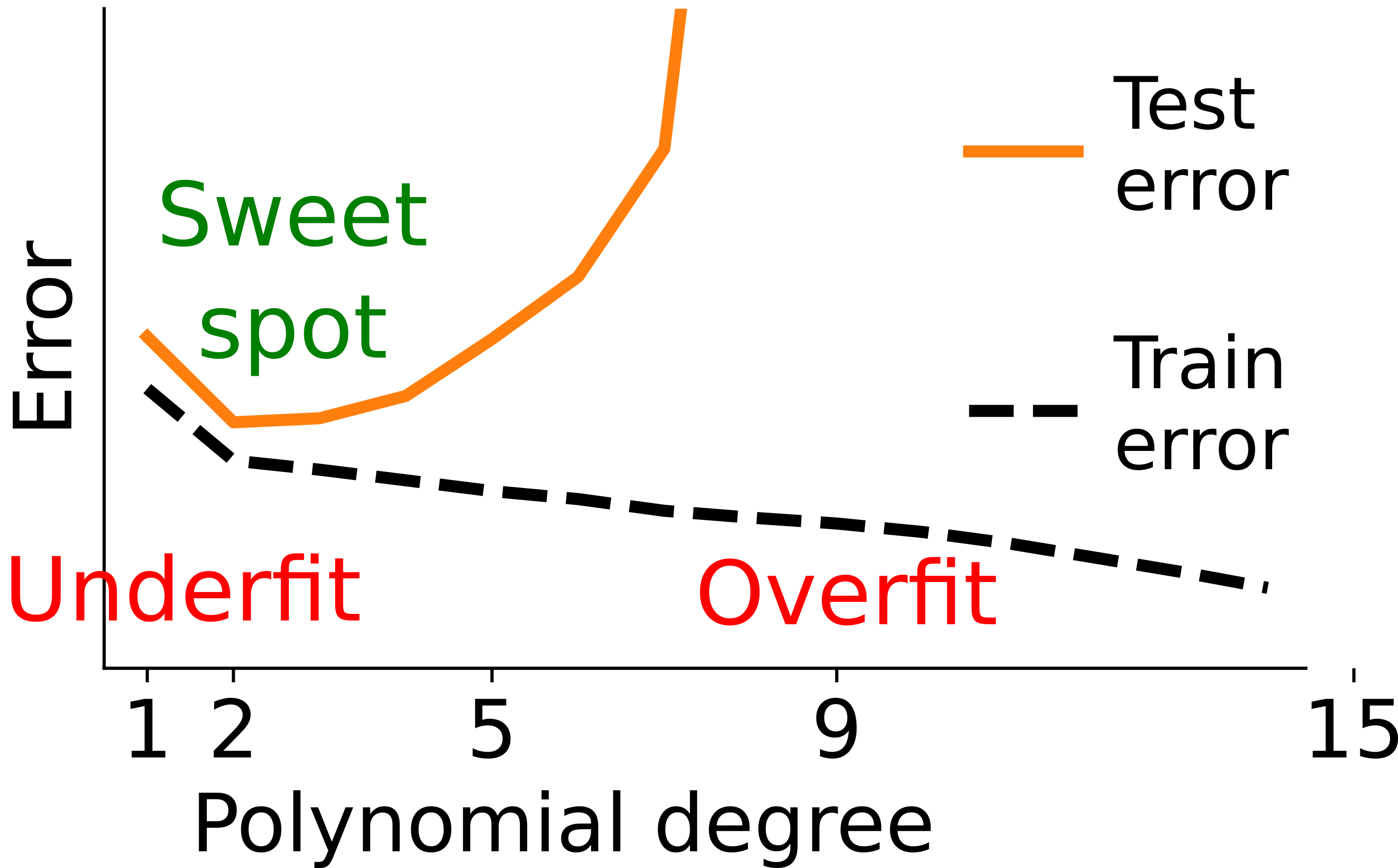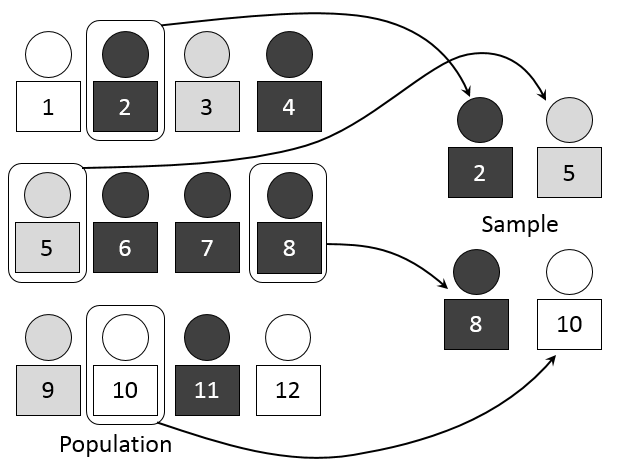Overfitting/Underfitting and Bias/Variance#
Define a supervized-learning problem
Define and solve an Ordinary Least Squares problem
Understand when and why a model does or does not generalize well on unseen data
Understand the difference between the train error and the prediction error.
Understand overfitting-underfitting and bias-variance tradeoffs
Overfitting and Underfitting#
Which fit do you prefer?
Which model performs better on new data?
A harder example:
Varying model complexity#
Data generated by a random process
Sample a value of \(X\)
Transform with 9th-degree polynomial
Add noise to get samples of \(Y\)
Varying model complexity#
Data generated by a random process
In fact, this process is unknown
We can only access observations
Varying model complexity#
Data generated by a random process
In fact, this process is unknown
We can only access observations
Fit polynomials of various degrees
Varying model complexity#
Data generated by a random process
In fact, this process is unknown
We can only access observations
Fit polynomials of various degrees
Varying model complexity#
Data generated by a random process
In fact, this process is unknown
We can only access observations
Fit polynomials of various degrees
Varying model complexity#
Data generated by a random process
In fact, this process is unknown
We can only access observations
Fit polynomials of various degrees
Varying model complexity#
Data generated by a random process
In fact, this process is unknown
We can only access observations
Fit polynomials of various degrees
Overfit: model too complex#
Model too complex for the data:
Its best fit would approximate well the process
However, its flexibility captures noise
Not enough data - Too much noise
Underfit: model too simple#
Model too simple for the data:
Best fit would not approximate well the process
Yet it captures little noise
Plenty of data - Low noise
Partial Summary#
Models too complex for the data overfit:
they explain too well the data that they have seen
they do not generalize
Models too simple for the data underfit:
they capture no noise
they are limited by their expressivity
Comparing Train and Test Errors#
Train vs Test (Prediction) Error#
Error for \(\hat{f}\) from train data \((\mathbf{x}_i, y_i), 1 \le i \le N\):
Error on the test data (generalization):
The EPE is the expectation of \(\mathrm{Err}_\hat{f}\) over all possible train data.
The train error is easy to estimate but does not tell us much:
there is always a model that is sufficiently complex to predict the training data perfectly (e.g. 1-nearest neighbors, Legendre approximating polynomials, deep-enough neural network, etc.)
but too complex models overfit
It is the test error that evaluates how the model performs on new data
It can be estimated:
on some data spared from the training (test data)
using more advanced methods such as cross-validation (see Tutorial: Overfitting/Underfitting and Bias/Variance)
Train vs test error: increasing complexity#
Train vs test error: increasing complexity#
Train vs test error: increasing complexity#
Train vs test error: increasing complexity#
Train vs Test Error: Validation Curve#

Train vs Test Error: Varying Sample Size#
Train vs Test Error: Varying Sample Size#
Train vs Test Error: Varying Sample Size#
Train vs Test Error: Learning Curve#
Irreducible Error#
Error of best model trained on unlimited data
Here, the data-generating process is a degree-9 polynomial
A higher-degree polynomial will not do better
Predictions limited by noise
Model Families#
Crucial to match:
statistical model
data-generating process
So far: polynomial for both
Some family names: linear models, decision trees, random forests, kernel machines, multi-layer perceptrons
Different Model Families#
Different inductive (learning) bias
Different notion of complexity
Different Model Families#
Partial Summary#
Models overfit:
number of samples in the training set is too small for model’s complexity
testing error is much bigger than training error
Models underfit:
models fail to capture the shape of the training set
even the training error is large
Different model families = different complexity
Bias versus Variance#
Resampling the Training Set#

By Dan Kernler - Own work, CC BY-SA 4.0
A limited amount of training data
Training set is a small random subset
of all possible observationsWhat is the impact of this choice of training set
on the learned prediction function?
Practice: Varying Sample Size, Noise Level and Complexity#
The following plot represents a 8th-order polynomial to which Gaussian noise is added and to which a polynomial is fitted by OLS.
Question
Explain changes in the fits depending on the sample size \(N\), noise level \(\sigma\) and model complexity \(m\) in terms of bias (mean error) and variance of the predictions.
from sklearn import linear_model
# Import modules
from pathlib import Path
import numpy as np
import pandas as pd
import holoviews as hv
hv.extension('bokeh')
import hvplot.pandas
import panel as pn
N = 100
M = 7
sc = 0.6
roots = np.linspace(-1 / sc, 1. / sc, M)
xlim = [-1.5, 1.5]
ylim = [-3, 3]
def poly(beta, x):
m = len(beta)
monomials = x**np.arange(m)
return beta @ monomials
def poly_roots(roots, x):
return np.prod(x - roots) + x
def plot(b, N=100, sigma=0.5, m=1):
x = np.sort(np.random.randn(N))
eps = np.random.randn(N)
fx = np.array([poly_roots(roots, x[i]) for i in range(len(x))])
ok = (fx > ylim[0]) & (fx < ylim[1])
x = x[ok]
fx = fx[ok]
x0 = np.linspace(*xlim, 100)
fx0 = np.array([poly_roots(roots, x0[i]) for i in range(len(x0))])
sy_truth = pd.Series(fx0, index=x0)
sy_truth.name = 'f(x)'
reg = linear_model.LinearRegression(fit_intercept=False)
X = np.array([x**i for i in range(m + 1)]).T
eps = eps[ok]
y = fx + sigma * eps
sy = pd.Series(y, index=x)
sy.index.name = 'x'
sy.name = 'y'
reg.fit(X, y)
X0 = np.array([x0**i for i in range(m + 1)]).T
sy_pred = pd.Series(reg.predict(X0), index=x0)
sy_pred.name = "f'(x)"
title = "f'(x) = " + '+'.join(
'{}*x^{}'.format(str(np.round(reg.coef_[i], 1)), i)
for i in range(len(reg.coef_)))
return sy_truth.hvplot(
color='k', line_dash='dashed', line_width=3) * sy.hvplot.scatter(
title=title, xlim=xlim, ylim=ylim, color='k') * sy_pred.hvplot(
color=hv.Cycle.default_cycles['default_colors'][0], line_width=3)
button = pn.widgets.Button(name='Resample', button_type='primary')
pn.interact(plot, b=button, N=np.arange(10, 310, 10),
sigma=np.arange(0., 1., 0.1), m=np.arange(0, 9))
Overfit: variance#
Overfit: variance#
Overfit: variance#
Overfit: variance#
Underfit: bias#
Underfit: bias#
Underfit: bias#
Underfit: bias#
Underfit versus Overfit#
Bias-Variance Decomposition of the EPE (Univariate)#
We assume that
where \(\mathbb{E}(\varepsilon) = 0\) and \(\mathrm{Var}(\varepsilon) = \sigma_\varepsilon^2\).
The EPE at a new point \(X = x_0\) for a model \(f\) is
where the expectation is taken with respect to the distribution of the train datasets (i.e. over all fits \(\hat{f}\) of \(f\)) and to the distribution of the output conditioned on \(x_0\).
Question (optional)
Show that $\( \mathrm{EPE}(f, x_0) = \sigma_\varepsilon^2 + \mathrm{Bias}^2[\hat{f}(x_0)] + \mathrm{Var}[\hat{f}(x_0)], \)$ where
\(\mathrm{Bias}^2[\hat{f}(x_0)] = \{\mathbb{E}[\hat{f}(x_0) - g(x_0)]\}^2 = \{\mathbb{E}[\hat{f}(x_0)] - g(x_0)\}^2\),
\(\mathrm{Var}[\hat{f}(x_0)] = \mathbb{E}[(\hat{f}(x_0) - \mathbb{E}[\hat{f}(x_0)])^2]\).
Question
What kind of error does each of these 3 terms represent?
Question
Interpret the validation and learning curves above based on the bias-variance decomposition.
Bias-Variance Decomposition for the OLS#
Question (optional)
Show that, the in-sample error is given by $\( \frac{1}{N}\sum_{i = 1}^N \mathrm{EPE}(f, x_i) = \sigma_\varepsilon^2 + \frac{1}{N} \sum_{i = 1}^N \{\mathbb{E}[\hat{f}(x_i)] - g(x_i)\}^2 + \frac{p}{N} \sigma_\varepsilon^2. \)$
Question
What kind of error does each of these 3 terms represent?
Partial Summary#
High bias == underfitting:
systematic prediction errors
the model prefers to ignore some aspects of the data
mispecified models
High variance == overfitting:
prediction errors without obvious structure
small change in the training set, large change in model
unstable models
To Go Further#
Absence of overfitting issue in Bayesian approach (e.g. Chap. 3 in Bishop 2006).
References#
Credit#
Contributors include Bruno Deremble and Alexis Tantet. Several slides and images are taken from the very good Scikit-learn course.








